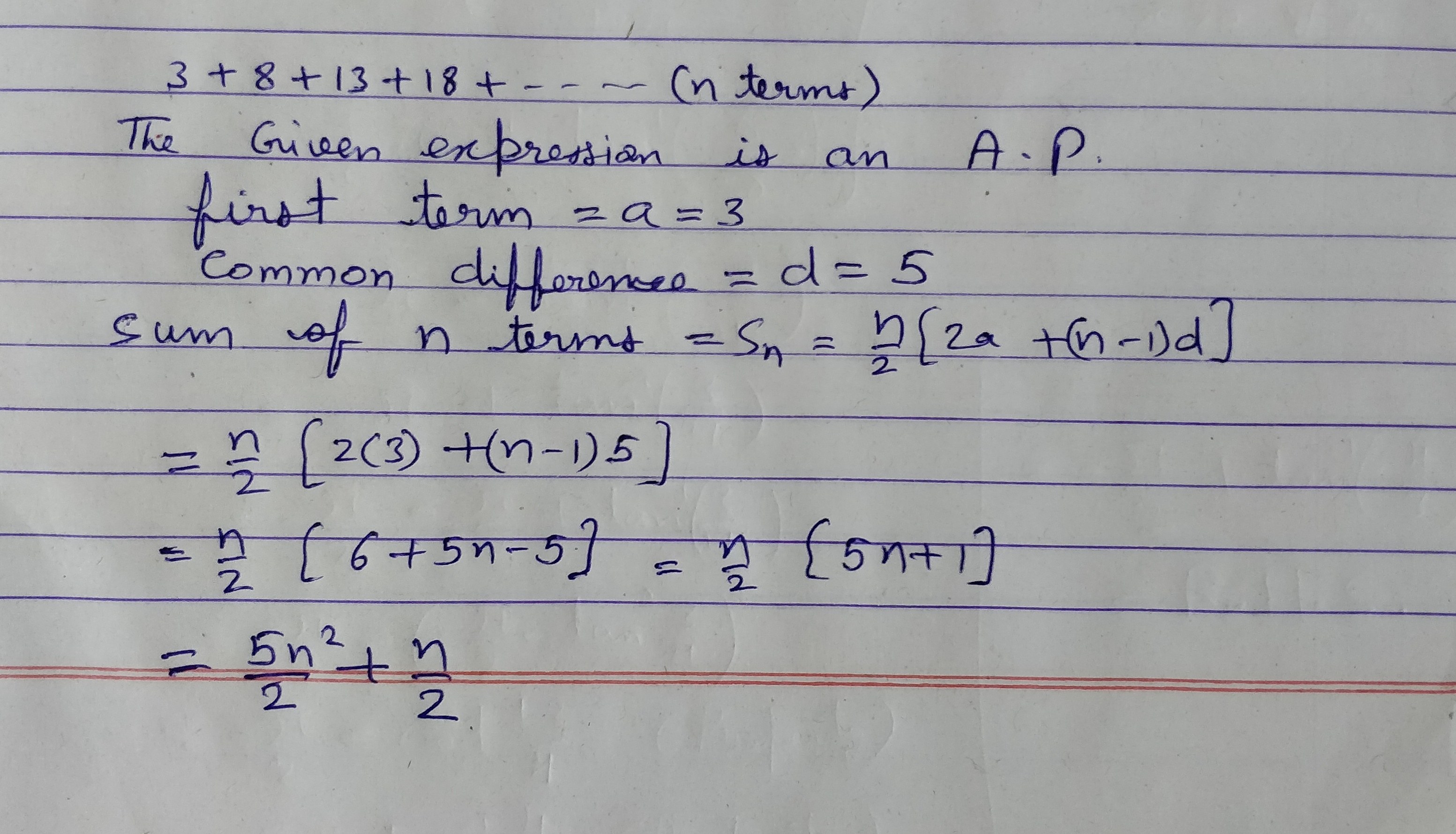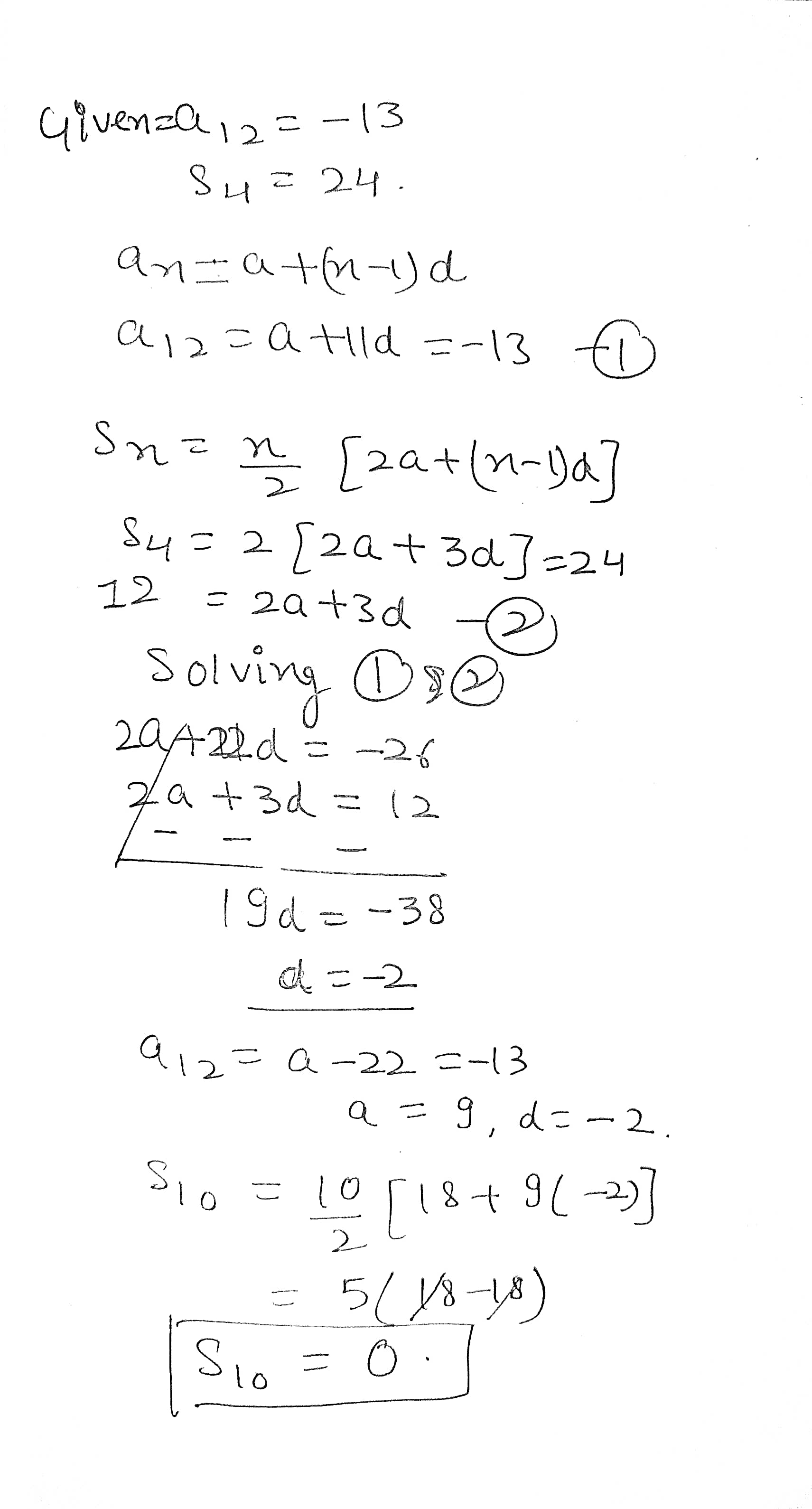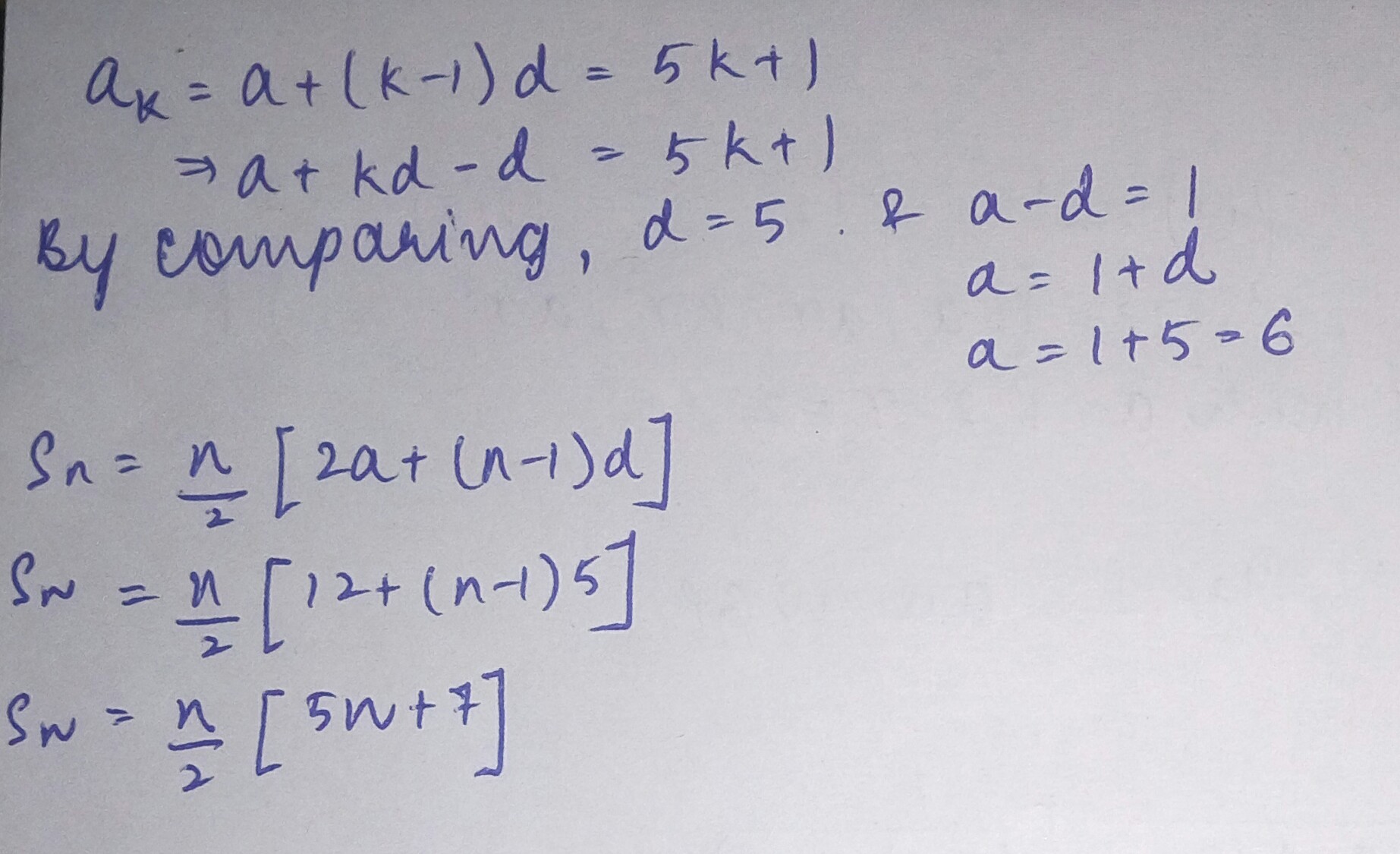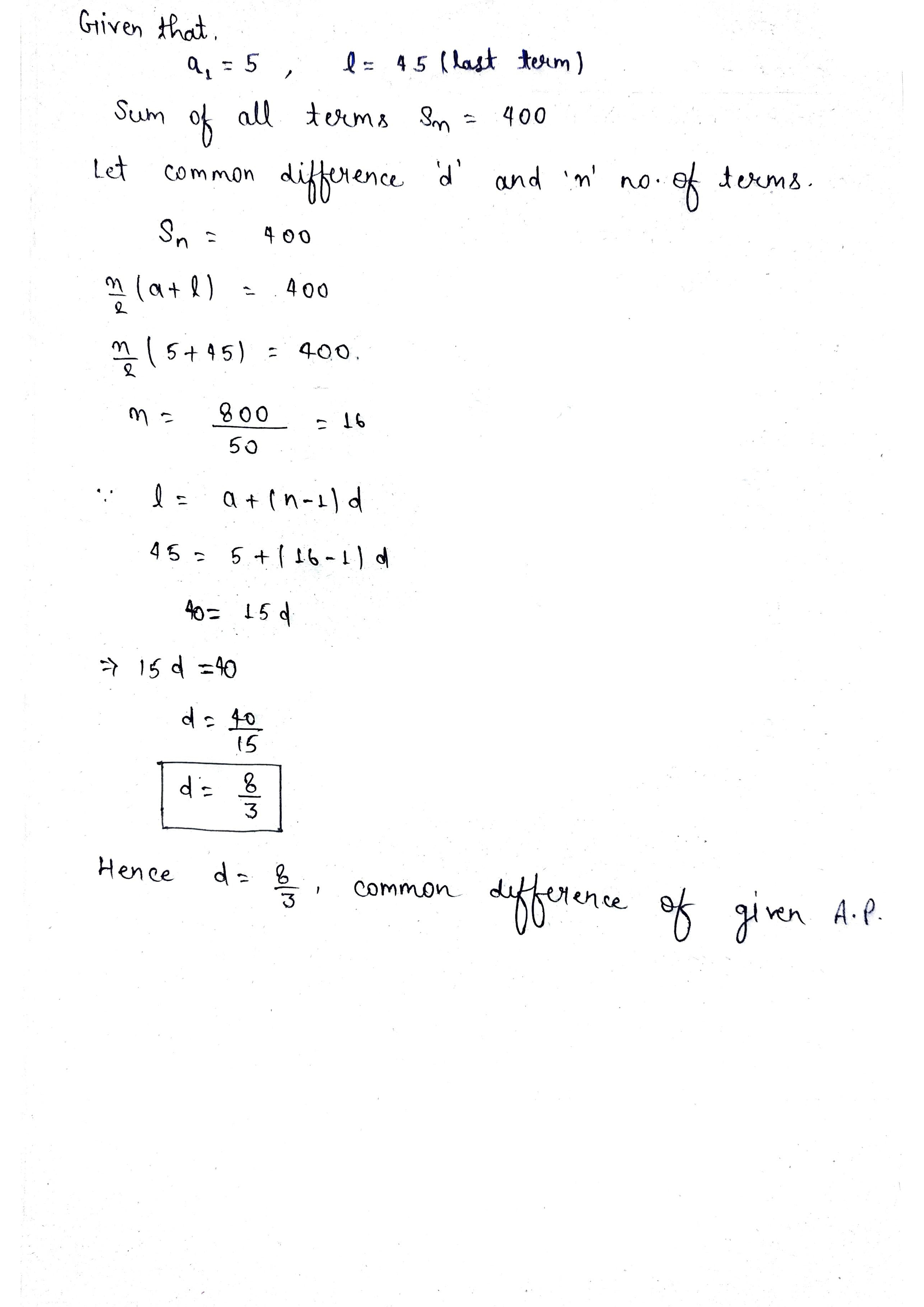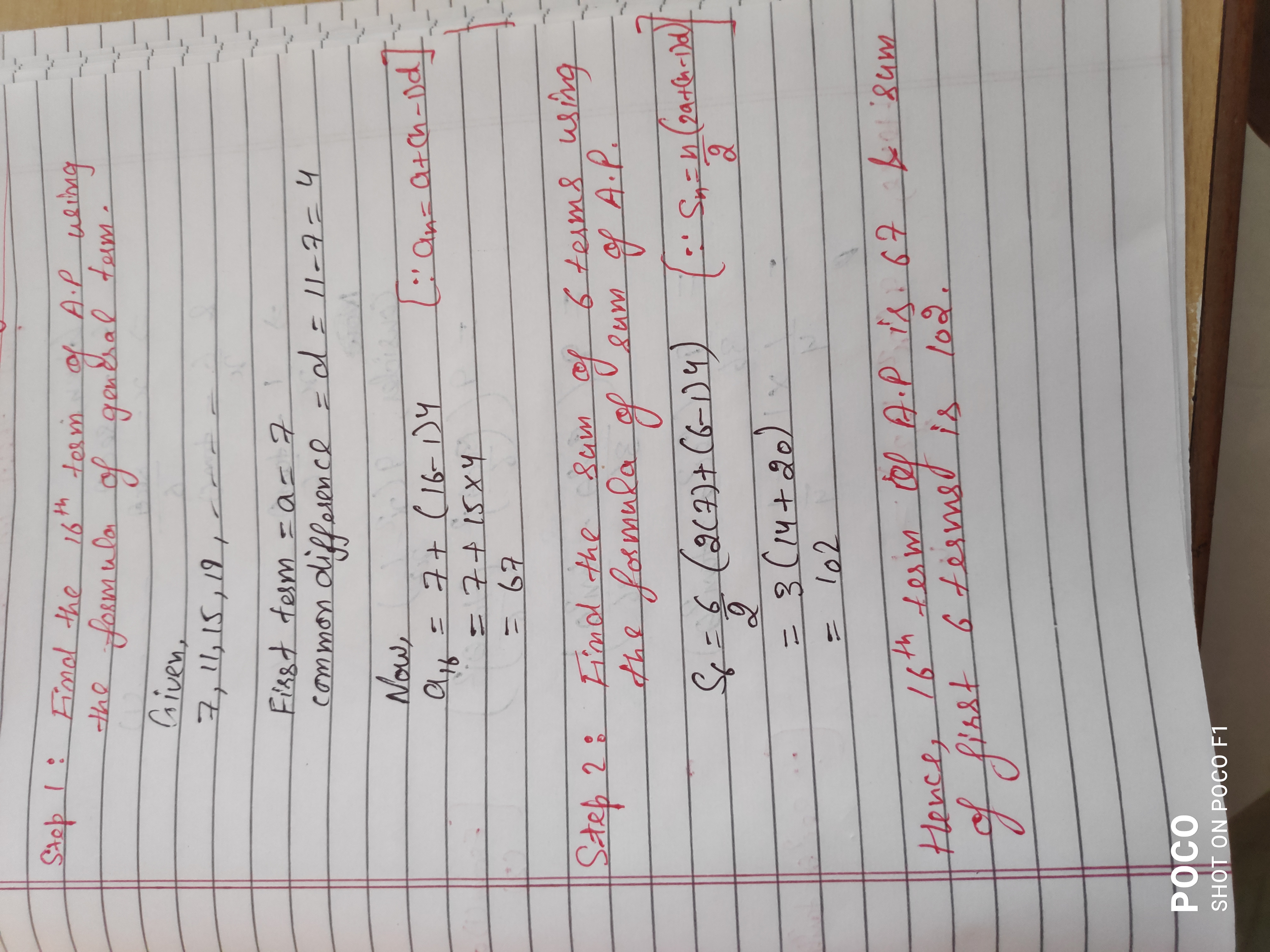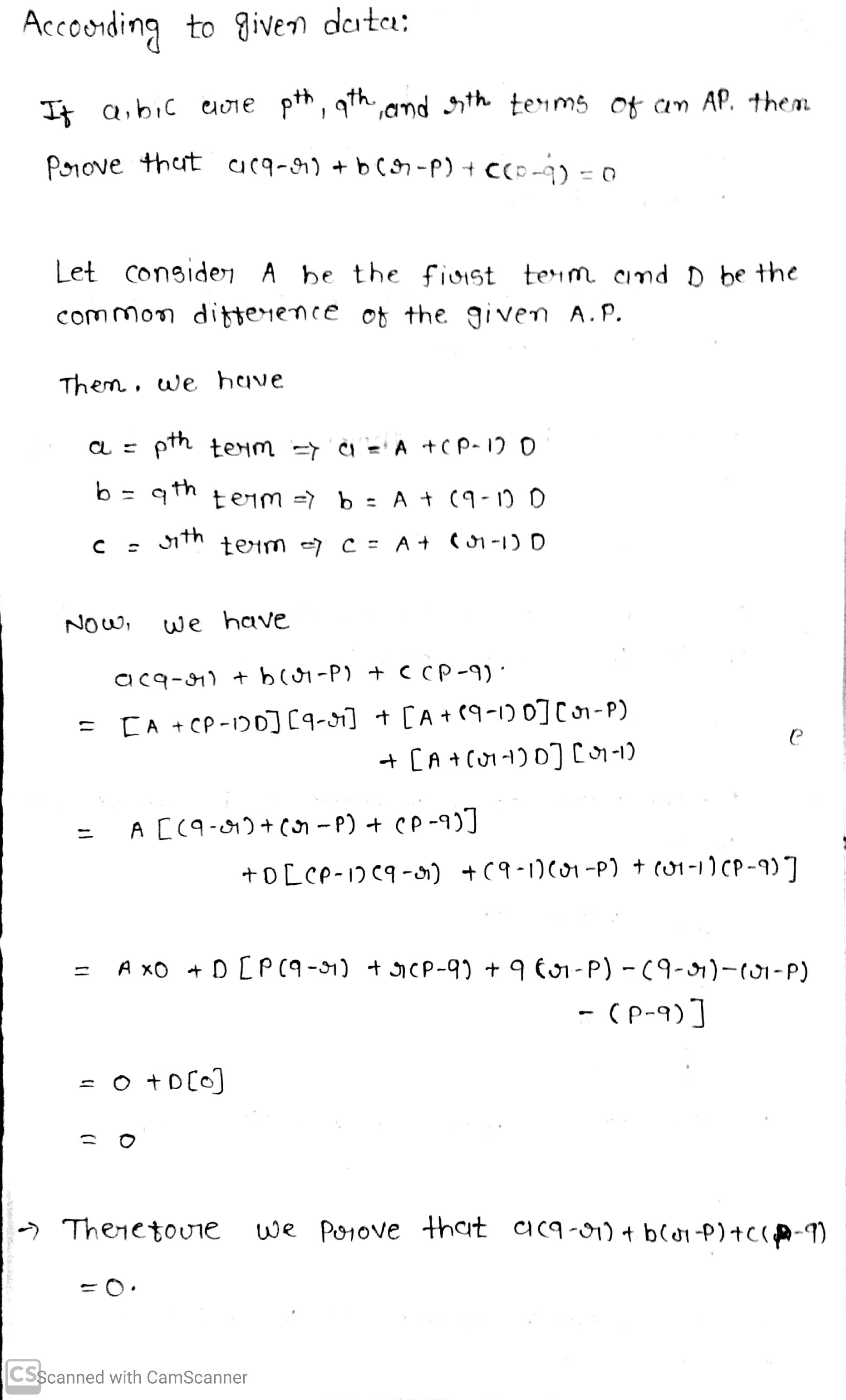Arithmetic Progressions - Class 10 Maths - Extra Questions
Find the $$20^{th}$$ term of the AP whose $$7^{th}$$ term is 24 less than the $$11^{th}$$ term, first term being 12.
Is 0 a term of the AP: 31, 28, 25, ...?
If true then enter $$1$$ and if false then enter $$0$$
Find the eighteenth term of the A.P. $$1, 7, 13, 19, ..........$$
Find the sum of all three digit natural numbers which are divisible by $$7.$$
Find the common difference the following A.P
$$1, 4, 7, 10, 13, 16,.. $$
The difference between any two consecutive interior angles of a polygon is $$\displaystyle {5} ^ {o}$$ . If the smallest angle is $$\displaystyle {120} ^ {o}$$, find the number of the sides of the polygon.
A man starts repaying a loan as first installment of Rs. $$100$$. If he increases the installment by Rs $$5$$ every month. what amount he will pay in the $$30^{th}$$ installment?
Find the sum of the first $$40$$ positive integers divisible by $$6$$
The $$17^{th}$$ term of an $$AP$$ exceeds its $$10^{th}$$ term by $$7$$. Find the common difference.
Obtain the sum of the first $$56$$ terms of an A.P whose $$18^{th}$$ and $$39^{th}$$ terms are $$52$$ and $$148$$ respectively.
Find the eleventh term of the A.P.$$7,13,19,25,........$$
Check whether the following sequence is an A.P. or not.
$$1,3,6,10,....$$
Check whether the following sequence is an A.P. or not?
$$1, 4, 7, 10, ...$$
Check whether 13, 19, 25, 31, ............ form an A.P.
The $$11^{th}$$ term and the $$21^{st}$$ term of an A.P. are $$16$$ and $$29$$ respectively, then find the first term and common difference.
Find the ninth term of the A.P.: $$3, 7, 11, 15$$...... .
Find the term $$t_{15}$$ of an A.P.:
$$4, 9, 14, .....$$
For the given A.P. 5, 10, 15, 20 ____Find the common difference (d).
Check whether the following sequence is an A.P. or not:
$$2, 6, 10, 14, .....$$
Write any two arithmetic progressions with common difference $$5$$.
Write any two arithmetic progressions with common difference $$3$$.
Write any two arithmetic progressions with common difference $$2$$.
Find the term $$t_{13}$$ of an A.P.
$$4, 9, 14, ....$$
There is an auditorium with $$35$$ rows of seats. There are $$20$$ seats in the first row, $$22$$ seats in the second row, $$24$$ seats in the third row and so on. Find the number of seats in the twenty-third row.
For an A.P., $$t_{3} = 8$$ and $$t_{4} = 12$$. Find the common difference $$d$$.
For the given A. P. $$10, 15, 20, 25,$$......., find the common difference '$$d$$'.
In a given A.P. $$a=8,{T}_{n}=33,{S}_{n}=123$$. Find $$d$$ and $$n$$.
Check whether the following sequence is an AP or not:
$$3m - 1, 3m - 3, 3m - 5, ....$$
If $$t_{n} = 3n + 5$$, then find A.P.
Find the first term and common difference of the following APsv
(i) $$5, 2, -1, -4, ....$$(ii) $$\dfrac {1}{2}, \dfrac {5}{6}, \dfrac {7}{6}, \dfrac {3}{6}, ...., \dfrac {17}{6}$$
Write the common difference of the A.P. 7, 5, 3, 1, -1, -3, .........
Write any two arithmetic progressions with common difference $$4$$.
In an A.P. the first term is $$2$$, the last term is $$29$$, and the sum is $$155$$, then find the common difference.
Find the common difference of an AP: $${ 1 }^{ 2 },{ 5 }^{ 2 },{ 7 }^{ 2 },73,....$$
For the following arithmetic progressions write the first term $$a$$ and the common difference $$d$$:
$$0.3,0.55,0.80,1.05,....$$
For the following arithmetic progressions write the first term $$a$$ and the common difference $$d$$:
$$\cfrac { 1 }{ 5 } ,\cfrac { 3 }{ 5 } ,\cfrac { 5 }{ 5 } ,\cfrac { 7 }{ 5 } ,.....$$
Find the common difference of the A.P.: $$1.,2.0,2.2,2.4,.....$$
Find the common difference of am AP: $$-225,-425,-625,-825,.....$$
Find the common difference of the A.P. and write the next two terms: $$75,67,59,51,.....$$
For the following arithmetic progressions write the first term $$a$$ and the common difference: $$-5,-1,3,7,....$$
For the following arithmetic progressions write the first term $$a$$ and the common difference $$d$$:
$$-1.1,-3.1,-5.1,-7.1,.....$$
Find the common difference of the A.P.: $$119,136,153,170,.....$$
The $$n$$th term of an A.P is $$6n+2$$. Find the common difference.
The first and the last terms of an A.P are $$7$$ and $$49$$ respectively. If the sum of all its terms is $$420$$, find its common difference.
Find the common difference and write the next three terms of the A.P. $$3, -2, -7, -12,....$$
Find the value of $$x$$ for which $$\left( {5x + 2} \right),\left( {4x - 1} \right)\;and\;(x + 2)$$ are in A.P
State whether the given list of numbers is an arithmetic progression or not.$$ a) 13,20,27,34,...$$$$ b) 6,16,26,35,...$$
Find the value of $$k$$ , for which $$2k + 7 , 6k - 2$$ and $$8k + 4$$ are $$3$$ consecutive terms of an AP.
Find the sum of the following $$AP$$.
$$-37,-33,-29,.....,$$ to $$12$$ terms
If in an AP, the sum of first 10 terms is -150 and the sum of its next 10 terms is -550. Find the AP.
For the A.P. $$-1.1,\ -3.1,\ -5.1,\ -7.1,......$$ write the first term and the common difference.
In an A.P., if $$t_7=13$$ and $${S_{14}} = 203$$, find $$S_8$$.
Write the expression for the common difference of an$$A.P$$ whose first term is $$a$$ and $$nth$$ term is $$b$$.
If $$a=2$$ and $$d=4$$ , then $$S_{20} =$$ _______.
If sum of first $$p$$ terms of an AP is equal to the sum of first $$q$$ terms, then find the sum of the first $$(p+q)$$ terms.
Find the common difference $$d$$ and write three more terms if the following sequence is an AP:$$2, 4, 8, 16,.$$
In an arithmetic progression of which $$a$$ is the first term. If the sum of the first ten terms is zero and the sum of next ten terms is $$-200$$ then find the value of $$a$$.
The $${25^{th}}$$ term of $$AP$$ $$ - 5,\dfrac{{ - 5}}{2},0,\dfrac{5}{2}............ \ \ $$ is $$-b$$,
then what is the value of $$b?$$
Show that sequence of following $$n^{th}$$ terms ,are not in A.P.
$$\dfrac{n}{n+1}$$
Find the sum of n terms of the series $$(a^2+b)+({ a }^{ 2 }+2b)+({ a }^{ 2 }+3b)+....$$
The first term and the last term of an A.P are $$17$$ and $$350$$ respectively. If the common difference is $$9$$. How many terms are there and what is their sum.
Find the common difference in the following pattern:
(a) 4,7,10,13
(b) 5,9,13,17,21,25
Find the 20th term of the progression.
$$-12,-5,2,9,16,23,30,....$$
Find the common difference of the following A.P.:i) $$3,1,-1,-3,......$$ii) $$-5,-1,3,7,.....$$
The ratio of the sums of m and n terms of an A.P. is $${ m }^{ 2 }:{ n }^{ 2 }$$. Show that the ratio of $${ m }^{ th }$$ and $${ n }^{ th }$$ term is (2m - 1) : (2n - 1).
Check whether the following sequence is an AP or not:
$$-1.2,-3.2,-5.2,-7.2$$...
Is the given Progression arithmetic progression?
$$2, 6, 7, 10, 12, 15,.........$$
Is the given progression arithmetic progression?
$$-1, -3, -5, -7,.........$$
What is the common difference of an A.P. in which $$a_{24}-a_{17}=-28$$?
Is the given Progression arithmetic progression?Why$$2, 3, 5, 7, 8, 10, 15,.........$$
Is the given sequence $$2,4,8,16$$ form an A.P. If it forms an AP, find the common difference $$d$$
Find the common difference of the following AP:
$$3.3 + \sqrt { 2, } 3+2\sqrt { 2 } ,3+3\sqrt { 2 } $$
Find the first term $$a$$ and the common difference $$d$$ of A.P. : $$-5, -1, 3, 7, .....$$
Which term of the sequence $$72, 70, 68, 66$$, ... is $$40 $$?
Is the sequence $$\sqrt{3},\sqrt{6},\sqrt{9},\sqrt{12},......$$ from an Arithmetic Progression?Give reason.
Check whether the following sequence is an AP or not:
$$1,3,9,27,....$$
Is the given sequence an AP? If it forms an AP, find the common difference $$d$$ and write the next three terms.
$$0,-4, -8 ,-12$$....
For the following A.P's write the first term and common difference:$$\dfrac{3}{2},\dfrac{1}{2},-\dfrac{1}{2},-\dfrac{3}{2},......$$
Is the given sequence $$3,3+\sqrt { 2 } ,3+2\sqrt { 2 } ,3+3\sqrt { 2 }$$ form an APs? If it forms an AP, find the common difference $$d$$ and write the next three terms.
Check whether the following the sequence is an AP or not:
$$-10, -6, -2, 2$$....
How many terms of the A.P. $$-6, - \frac{11}{2}, -5, .....$$ are needed to give the sum $$-25$$??
Check whether the following sequence is an A.P. or not:
$$ 0.2,0.22,0.222...$$
Check whether the following sequence is an arithmetic progression or not:
$$5, 9, 12, 18, ….$$
For the following AP, write the first term and the common difference :
$$-5, -1, 3, 7, ....$$
The sum of the $$5^{th}$$ and the $$7^{th}$$ terms of an AP is 52 and the $$10^{th}$$ term is 46
then the AP is 1, 6, 11, 16.......
If true then enter $$1$$ and if false then enter $$0$$
The 26th, 11th and the last term of an AP are 0, 3 and $$-\frac{1}{5}$$ , respectively. Find the number of terms.
Find the $$12^{th}$$ term from the end of the A.P. $$2, 4, 6,..., 100.$$
If $$a_n = 3 4n$$, find $$S_{20}$$ .
Find whether 55 is a term of the AP: 7, 10, 13,--- or not. If yes, find which term it is.
If sum of the $$3^{rd}$$ and the $$8^{th}$$ terms of an AP is 7 and the sum of the $$7^{th}$$ and the $$14^{th}$$ terms is 3, find the $$10^{th}$$ term to closest integer.
If the nth terms of the two APs: 9, 7, 5, ... and 24, 21, 18,... are the same, find the value of n.
Find $$a + b + c$$ such that the following numbers are in AP: a, 7, b, 23, c.
Which term of the AP: 2, 7, 12,... will be 77?
Column II give common difference for A.P. given in column I, match them correctly.
If the sum of first 8 and 19 terms of an A.P. are 64 and 361 respectively, find the common difference.
The sum of first n terms of A.P. is $$3n\, +\, n^{2}$$ thenFind sum of first two terms.
Any odd square i.e $$\displaystyle \left [ 2n+1 \right ]^{2} $$ is equal to sum of n terms of an A.P. in increased by unity. Find the first term of that A.P ?
The nth term of a series is given to be $$\displaystyle \frac{3+n}{4},$$ find the sum of 105 term of this series.
Find sum of all odd integers between $$2$$ and $$100$$ divisible by $$3$$.
If $$t_{54}$$ of an A.P. is $$-61$$ and $$t_{4}=64,$$ find $$t_{10}.$$
Find the number of terms in the sequence $$4, 12, 20, ...,108.$$
The sum 'S' of first n natural numbers is given by the relation $$\displaystyle S=\frac{n(n+1)}{2}$$. Find n if the sum is 276.
Find the sum of all three digit natural numbers which are divisible by 7.
Find $$\displaystyle 20^{th} $$ term from the end of an $$AP\ 3, 7, 11, ......, 407$$
Find the first term and the common difference of an AP, if the $$3^{rd}$$ term is $$6$$ and the $$17^{th}$$ term is $$34$$.
Find the sum of the first $$22$$ terms of an AP, whose first term is $$4$$ and the common difference is $$\dfrac {4}{3}$$.
Find the sum of first 100 natural numbers.Or$$\displaystyle\sum_{x=1}^{100}{x}=? $$
The $$\displaystyle { p }^{ th },{ q }^{ th }$$ and $$ { r }^{ th }$$ terms of an A.P. are $$a,b,c$$ respectively. Show that $$(q - r)a + (r - p)b + (p - q)c = 0$$
How many terms are needed in the series $$-15$$, $$-12$$, $$-9$$, $$\dots\dots$$ so that their sum is 18?
A man deposited $$Rs\ 10000$$ in a bank with interest rate of $$5\%$$ simple interest annually. Find the amount in $$15 th$$ year since he deposited the amount and also calculate the total amount after $$20$$ years.
Find the sum of terms given below. $$34+32+30+.....+10$$
In an AP: Given $$a=3, n=8, S=192$$, find d
Ramkali saved Rs. $$5$$ in the first week of a year and then increased her weekly savings by $$Rs.\ 1.75$$. If in the $$n^{ th}$$ week, her weekly savings become Rs. $$20.75$$. Find $$n$$.
How many three-digit numbers are divisible by $$7$$?
Which term of the AP : $$ 3, 15, 27, 39, . . $$. will be $$132$$ more than its $$54^{th}$$ term.
Determine the $$AP$$ whose third term is $$16$$ and the $$7^{th}$$ term exceeds the $$5^{th}$$ term by $$12$$
Subba Rao started work in $$1995$$ at an annual salary of Rs. $$5000$$ and received an increment of Rs. $$200$$ each year. In which year did his income reach Rs. $$7000$$
Which of the following are APs ? If they form an AP, find the common difference $$d$$ and write three more terms.
(i) $$2, 4, 8, 16, ....$$
(ii) $$\displaystyle 2,\frac { 5 }{ 2 } ,3,\frac { 7 }{ 2 } ,...$$
(iii) $$\displaystyle -1.2,-3.2,-5.2,-7.2,...$$
(iv) $$\displaystyle -10,-6,-2,2,...$$
(v) $$\displaystyle 3,3+\sqrt { 2 } ,3+2\sqrt { 2 } ,3+3\sqrt { 2 } $$
(vi) $$\displaystyle 0.2,0.22,0.222,0.2222,....$$
(vii) $$\displaystyle 0,-4,-8,-12,...$$
(viii) $$\displaystyle -\frac { 1 }{ 2 } ,-\frac { 1 }{ 2 } ,-\frac { 1 }{ 2 } ,-\frac { 1 }{ 2 } ,...$$
(ix) $$\displaystyle 1,3,9,27$$
(x) $$\displaystyle a,2a,3a,4a,...$$
(xi) $$\displaystyle a,{ a }^{ 2 },{ a }^{ 3 },{ a }^{ 4 },...$$
(xii) $$\displaystyle \sqrt { 2 } ,\sqrt { 8 } ,\sqrt { 18 } ,\sqrt { 32 } ,...$$
(xiii) $$\displaystyle \sqrt { 3 } ,\sqrt { 6 } ,\sqrt { 9 } ,\sqrt { 12 } ,...$$
(xiv) $$\displaystyle { 1 }^{ 2 },{ 3 }^{ 2 },{ 5 }^{ 2 },{ 7 }^{ 2 },..$$
(xv) $$\displaystyle { 1 }^{ 2 },{ 5 }^{ 2 },{ 7 }^{ 2 },73,..$$
Write first four terms of the AP, when the first term $$a$$ and the common difference $$d$$ are given as follows:
(i) $$a=10, d=10$$
(ii) $$a=-2, d=0$$
(iii) $$a=4, d=-3$$
(iv) $$a=-1, d=$$ $$\displaystyle \frac { 1 }{ 2 } $$
(v) $$a=-1.25, d=-0.25$$
For the following APs, write the first term and the common difference:
(i) $$3, 1, -1, -3, ....$$
(ii) $$-5, -1, 3, 7, .....$$
(iii) $$\displaystyle \frac { 1 }{ 3 } ,\frac { 5 }{ 3 } ,\frac { 9 }{ 3 } ,\frac { 13 }{ 3 } ,....$$
(iv) $$0.6, 1.7, 2.8, 3.9, ...$$
For what value of $$n$$, are the $$nth$$ terms of two $$APs : 63, 65, 67, ...$$ and $$3, 10, 17$$, .... equal?
In the following APs, find the missing terms in the boxes :
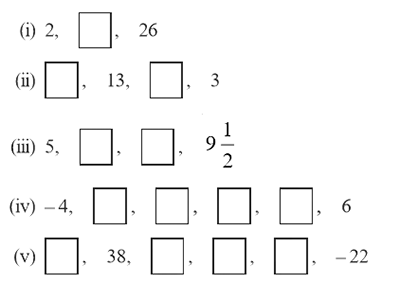
A contract on construction job specifies a penalty for delay of completion beyond a certain date as follows: Rs. $$200$$ for the first day, Rs. $$250$$ for the second day, Rs. $$300$$ for the third day, etc., the penalty for each succeeding day being Rs. $$50$$ more than for the preceding day. How much money the contractor has to pay as penalty, if he has delayed the work by $$30$$ days.
In a potato race, a bucket is placed at the starting point, which is $$5$$ m from the first potato, and the other potatoes are placed $$3$$ m apart in a straight line. There are ten potatoes in the line (see Fig.).
A competitor starts from the bucket, picks up the nearest potato, runs back with it, drops it in the bucket, runs back to pick up the next potato, runs to the bucket to drop it in, and she continues in the same way until all the potatoes are in the bucket. What is the total distance the competitor has to run?
[Hint : To pick up the first potato and the second potato, the total distance (in metres) run by a competitor is $$\displaystyle 2\times 5+2\times \left( 5+3 \right) $$]

A spiral is made up of successive semicircles, with centers alternately at $$A$$ and $$B$$, starting with center at $$A$$, of radii $$0.5\ cm, 1.0\ cm,1.5\ cm,2.0\ cm$$, . . . as shown in Fig. What is the total length of such a spiral made up of thirteen consecutive semicircles
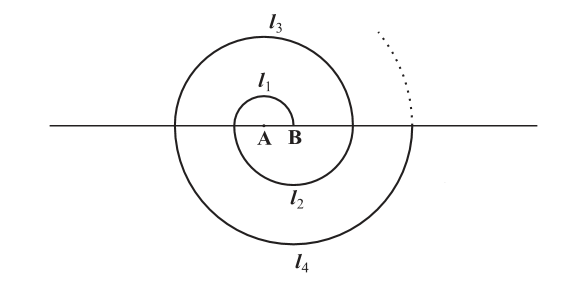
A sum of Rs. $$700$$ is to be used to give seven cash prizes to students of a school for their overall academic performance. If each prize is Rs. $$20$$ less than its preceding prize, find the value of each of the prizes.
In a school, students thought of planting trees in and around the school to reduce air pollution. It was decided that the number of trees, that each section of each class will plant, will be the same as the class, in which they are studying, e.g., a section of Class $$I$$ will plant $$1$$ tree, a section of Class $$II$$ will plant $$2$$ trees and so on till Class $$XII$$. There are three sections of each class. How many trees will be planted by the students?
$$200$$ logs are stacked in the following manner: $$20$$ logs in the bottom row, $$19$$ in the next row, 18 in the row next to it and so on. In how many rows are the $$200$$ logs placed and how many logs are in the top row.

The houses of a row are numbered consecutively from $$1$$ to $$49$$. Show that there is a value of $$x$$ such that the sum of the numbers of the houses preceding the house numbered $$x$$ is equal to the sum of the numbers of the houses following it. Find this value of $$x$$.
A ladder has rungs $$25$$ cm apart. The rungs decrease uniformly in length from $$45$$ cm at the bottom to $$25$$ cm at the top. If the top and the bottom rungs are $$\displaystyle 2\dfrac { 1 }{ 2 } m$$ apart, what is the length of the wood required for the rungs
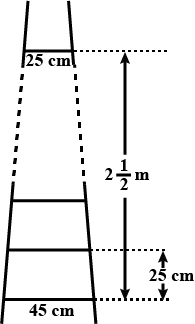
Find the sum of the first $$50$$ even positive integers.
Find $${s}_{30}$$ for an AP, where $${a}_{10}=20$$ and $${a}_{20}=58$$.
Define arithmetic progression with one example.
Find the common difference $$d$$ for an AP, where $${a}_{1}=10$$ and $${a}_{20}=466$$
Find the sum of all of the odd integers between $$200$$ and $$400$$
Find the sequence if, $$T_n = 2n - 1$$
In an A.P. if $$a = 13$$, $$T_{15} = 55$$, find $$d$$.
Find the sequence if, $$T_n = 5n + 1$$
Obtain the sum of the first $$56$$ terms of an A.P whose $$25^{th}$$ and $$32^{nd}$$ terms are $$52$$ and $$148$$ respectively.
If the sum of the first $$12$$ terms of an A.P. is $$468$$ and its common difference is $$6$$, find the $$10^{th}$$ term
Find the fifteenth term of the A.P.: $$7,13,19,25,...$$
Find the sum of first 15 terms of an A.P. whose 5th and 9th terms are 26 and 42 respectively
How many terms of the A.P. 17, 15, 13, ...... must be taken, so that their sum is 81?
Find the eighteenth term of the A.P$$7,13,19,25,....$$
What is the common difference of an A.P., in which $$a_{21} - a_7 = 644$$.
For an A, P, $$\dfrac{1}{3}, \dfrac{4}{3}, \dfrac{7}{3}, \dfrac{10}{3} .........., $$ Find $$T_{18^o}$$
For an A, P, 3, 9, 15, 21 ............, Find $$S_{10^o}$$
Find the sum of the following numbers without actually adding the numbers.
(i) $$1 + 3 + 5 + 7 + 9 + 11 + 13 + 15$$
(ii) $$1 + 3 + 5 + 7$$
(iii) $$1 + 3 + 5 + 7 + 9 + 11 + 13 + 15 + 17$$
In an A.P., prove that $$d=S_n -2S_{n-1}+S_{n-2}$$.
Find the common difference and $$15^{th}$$ term of the A.P. $$125, 120, 115, 110,$$ ______
The product of the third by the sixth term of an arithmetic progression is $$406$$. The division of the ninth term of the progression by the fourth term gives a quotient $$2$$ and a remainderFind the first term and the difference of the progression.
If $$t_{n}$$, represents $$n^{th}$$ term of an A.P., $$t_{2}+ t_{5}-t_{3}=10$$ and $$t_{2} + t_{9}=17$$, then find its first term and its common difference.
Find the first term $$a$$ and the common difference $$d$$ of the arithmetic progression in which $$\displaystyle\, a_2\, +\, a_5 - a_3 = 10$$, $$\displaystyle\, a_2 + a_9 = 17$$
Find the common difference of the A.P.: $$0,\cfrac { 1 }{ 4 } ,\cfrac { 1 }{ 2 } ,\cfrac { 3 }{ 4 } ,...$$
Find the first term and the difference of an arithmetic progression if the sum of its first five even terms is equal to $$15$$ and the sum of the first three terms is equal to 3.
Find the sum of the following arithmetic progressions:
$$-26,-24,-22,....$$ to $$36$$ terms.
Find the sum of first $$22$$ terms of an A.P in which $$d=22$$ and $${a}_{22}=149$$.
The first term of an A.P is $$2$$ and the last term is $$50$$. The sum of all these terms is $$442$$. Find the common difference.
Find the sum of the following arithmetic progressions:
$$41,36,31,.....$$ to $$12$$ terms.
If the sum of a certain number of terms starting from first term of an A.P is $$25,22,19,.....$$ is $$116$$. Find the last term.
Find the sum of the following arithmetic progressions:
$$50,46,42,.....$$ to $$10$$ terms
Find the sum to $$n$$ terms of the A.P $$5,2,-1,-4,-7,.....$$
How many terms of the A.P $$63,60,57,....$$ must be taken so that their sum is $$693$$?
Find the sum of the arithmetic progressions: $$3, \dfrac{9}{2}, 16, \dfrac{15}{2},......$$ to $$25$$ terms
Find the sum of the following arithmetic progressions:
$$1,3,5,7,....$$ to $$12$$ terms
Find the sum of all integers between $$84$$ and $$719$$, which are multiples of $$5$$.
Show that the sum of all odd integers between $$1$$ and $$1000$$ which are divisible by $$3$$ is $$83667$$.
Find the sum of all integers between $$50$$ and $$500$$, which are divisible by $$7$$.
Find the sum of all odd numbers between $$100$$ and $$200$$
Find the sum of all natural numbers between $$1$$ and $$100$$, which are divisible by $$3$$.
Identify if a given sequence of numbers is an arithmetic progression or not.
a) $$8,17,26,35,...$$
b) $$-4,-9,-16,-25,..$$
Find the sum of the first $$15$$ terms of the following sequences having $$n$$th term as
$${ b }_{ n }=5+2n$$
Which of the following sequences forms an A.P.i) 0, 2, 0, 2,..............
ii) 11, 22, 33, 44,.................
ii) 11, 22, 33, 44,.................
If sum of first 6 terms of an AP is 36 and that of the first 16 terms is 256, then find the sum of first 10 terms.
Write down the common difference and the first term for the following arithmetic progressions.a) $$7,13,19,25,...$$b) $$-12,-4,4,12,...$$
Find the sum of first 25 terms of an AP whose nth term is 1 - 4n.
Find the minimum number of terms of the AP 64, 60, 56,... so that their sum is 540.
The sum of three numbers in A.P. is $$21$$ and the sum of their squares is $$197$$. Find the middle number.
Is the following sequence an $$AP$$? If true, find the common difference $$d$$ and write three more terms.$$-1.2, -3.2, -5.2, -7.2...$$
Find the common difference of AP whose $$n^{th}$$ term is $$6n + 2$$.
Find the sum to $$n$$ terms of the series:
$$1\times 2\times 3+2\times 3\times 4+3\times 4\times 5+.....$$
Check whether the following numbers are in A.P or not.
$$2, 4, 8, 16 ,\dots$$
In an A.P. sum of first $$n$$ terms is given by $$4n^2+3n$$. Then find the third term.
If $$a=8$$, $$t_n=62$$, $$S_n=20$$, find $$n$$.
On $$1^{st}$$ Jan $$2016$$, Sanika decides to save $$Rs.\ 10$$, $$Rs.\ 11$$ on second day, $$Rs.\ 12$$ on third day. If she decides to save like this, then on $$31^{st}$$ Dec $$2016$$ what would be her total saving?
Find the common difference $$d$$ and write three more terms of an $$AP$$:$$2,\dfrac {5}{2},3, \dfrac {7}{2}$$
Is the following sequence an $$AP$$? If true, find the common difference $$d$$ and write three more terms.
$$-10, -6, -2, 2,$$
The $${30^{th}}$$ term of the $$A.P \ series : 10,7,4....$$ is $$-b$$,
what is the value of $$b?$$
Check if given series is $$AP$$ or not? If it is an $$AP$$, find the common difference $$d$$ and write three more terms.$$3, 3+\sqrt {2}, 3+2\sqrt {2}, 3+3\sqrt {2},.$$
In an $$A.P$$ $$17^{th}$$ term is $$7$$ more then is $$10^{th}$$ term. Find the common difference ?
How many terms of the series $$-9, -6, -3, ...$$ must be taken that the sum may be $$66$$?
If the following sequence is an AP, then find the common difference.$$2,4,6,8$$
Is the following sequence an $$AP$$? If true, find the common difference $$d$$ and write three more terms.
$$0.2, 0.22, 0.222, .0.2222,..$$
If the sum of the first $$14$$ terms of an AP is $$1050$$ and its first term is $$10$$, find the $$20^{th}$$ term.
Is the following sequence an $$AP$$? If true, find the common difference $$d$$ and write three more terms.
$$0, -4, -8, -12,$$
How many terms of the A.P -6,$$ - \frac{{11}}{2}, - 5$$.......are needed to give the sum -25?
Find the sum of all odd numbers of four digits which are divisible by $$9$$.
For a given A.P, $$T_7 = 12 $$ and $$T_{12} = 72 , $$ then $$d= $$ _______
Is the following sequence an A.P. ? If yes, then find the common difference.
$$2, 4, 6, 8, ...$$
Find the common difference of an $$A.P.$$ whose $$n^{th}$$ term is $$3n+7$$.
If the following sequence is an AP, then find the common difference.
$$2,\dfrac {5}{2},3\dfrac {7}{2},....$$
Find the common difference of the A.P. $$y-7, y-2, y+3$$, _________.
Find the sum of first $$18$$ terms of the A.P. $$\dfrac{1}{3}, \dfrac{4}{3}, \dfrac{7}{3}, \dfrac{10}{3},...$$
Find the sum of the following A.P
$$2,7,12,.....$$ to $$10$$ terms
$$200$$ logs are in the stacked given manner. $$20$$ logs in the bottom row, $$19$$ in the next row, $$18$$ in the row next to it and so on. In how many rows are the $$200$$ logs place and how many logs are in the top row?

Find the first term and common difference of the given AP $$\displaystyle \frac { 3 } { 2 } , \frac { 1 } { 2 } , - \frac { 1 } { 2 } , - \frac { 3 } { 2 } , \dots$$
The sum of a series of terms in A.P. isIf the first term is 2 and the last term is 14, find the common difference.
If in an A.P., $${T}_{7}=18,{T}_{18}=7$$,then find $${T}_{101}$$
Find the sum of all $$2$$-digit odd positive numbers.
How many terms of the A.P: $$24,21,18,....$$ must be taken so that their sum is $$78$$?
Find the value of $$k$$ for which $$k, 2k-1$$ and $$2k+1$$ are in $$A.P$$.
Find the common difference and $$99th$$ term of the arithmetic progression :
$$ 7\dfrac { 3 }{ 4 } ,9\dfrac { 1 }{ 2 } ,11\dfrac { 1 }{ 4 } ,\dots \dots \dots \dots \dots \dots$$.
Find the sum of
$$3+8+13+18+....+n$$ terms
Find the sum of all odd integers between $$2$$ and $$100$$ divisible by $$3 $$.
Find the sum of the following AP $$1,3,5,7.............199$$
Find the value of K so that $$(K+2), (4K - 6)$$ and $$(3K - 6)$$ are three continuous terms of AP.
The first term of an $$A.P.$$ is $$5$$, the common difference is $$3$$ and the last term is $$80$$, find the number of terms.
Determine value of $$ k$$ so that $$3k-2$$ , $$4k-6$$ and $$k+2$$ are three consecutive terms of an $$AP.$$
Find the sum of the series: $$31, 32, ...., 50$$
If the 12th term of an AP is -13 and the sum of first four terms is 24, what is the sum of the first 10 terms?
Find the sum of $$90$$ terms of A.P $$4,\,8,\,12,...$$
Determine the AP whose $$3^{rd}$$ term is $$5$$ and the $$7th$$ term is $$9$$.
Find the sum of three digits numbers which are divisible by $$11$$
Find the sum to n terms of the A.P., whose $$k^{th}$$ term is $$5k+1$$.
Find the common difference of the A.P. given below:$$0.6, 1.7, 2.8, 3.9,.....$$
Is $$184$$ a term of the sequence $$3, 7, 11$$, ... ?
The common difference for the sequence: $$3, -1, -5, -9....$$ is $$-b$$, then what is the value of $$b?$$
Find the value of $$k$$, If $$x, 2x+k, 3x+5 $$ are consecutive terms in A.P.
For what value of $$k$$ will $$k+9,2k-1$$ and $$2k+7$$ are the consecutive terms of an A.P?
Find the common difference of an AP in which $${ a }_{ 18 }-{ a }_{ 14 }=32$$
State with reason, whether the sequence $$12,14,16,18,22,24,2,28,32,34,36,38,$$ is an $$\text{A.P.}$$ or not.
Is the given sequence 0.2, 0.22, 0.222, 0.2222.... an A.P.?
The first and the last term of an arithmetic progression are $$5$$ and $$45$$ respectively. If the sum of all its terms is $$400$$, find its common difference.
The $$9$$th term of an AP is $$-32$$ and the sum of its $$11$$th and $$13$$th terms is $$-94$$. Find the common difference of the AP.
Find the sum of all odd integers from $$1$$ to $$201$$.
Find $$10$$th term of the A.P. $$1, 4, 7, 10,...$$.
Write the common difference of an A.P. the sum of whose first $$n$$ terms is $$\dfrac{P}{2}n^2+Qn$$.
The sum of first $$7$$ terms of an AP is $$10$$ and that of next $$7$$ terms is $$17$$. Find the AP.
Write the sum of first n even natural numbers.
The $$7$$th term of an AP is $$-4$$ and its $$13$$th term is $$-16$$. Find the AP.
The $$4$$th term of an AP is $$11$$. The sum of the $$5$$th and $$7$$th terms of this AP is $$34$$. Find its common difference.
How many terms of the AP $$21, 18, 15,....$$ must be added to get the sum $$0$$?
If the sum of n terms of an A.P. is $$nP+\dfrac{1}{2}n(n-1)Q$$, where P and Q are constants, find the common difference.
Which of the following lists of numbers form an A.P.? If they form an A.P., find the common difference $$d$$:
(i) $$4,10,16,22, \dots$$
(ii) $$-2,2,-2,2, \dots$$
(iii) $$2,4,8,16, \dots$$
In an AP, it is given that $$S_5+S_7=167$$ and $$S_{10}=235$$, then find the AP, where $$S_n$$ denotes the sum of its first $$n$$ terms.
In an AP, the first term is $$22$$, $$n$$th term is $$-11$$ and sum of first $$n$$ terms is $$66$$. Find $$n$$ and hence find the common difference.
The first and the last terms of an AP are $$5$$ and $$45$$ respectively. If the sum of all its terms is $$400$$, find the common difference and the number of terms.
Find the sum of first n even natural numbers.
Find the sum of all odd numbers between $$0$$ and $$50$$.
In an AP, the first term is $$-4$$, the last term is $$29$$ and the sum of all its terms is $$150$$. Find its common difference.
What is the common difference of an AP in which $$a_{27}-a_7=84?$$
Find an AP whose $$4$$th term is $$9$$ and the sum of its $$6$$th and $$13$$th terms is $$40$$.
For the following A.P.s, write the first term 'a' and the common difference 'd':
(i) $$3,1,-1,-3, \dots$$
(ii) $$1 / 3,5 / 3,9 / 3,13 / 3, \dots$$
(iii) $$-3.2,-3,-2.8,-2.6, \dots .$$
(i) How many terms of the A.P. 25, 22, 19, … are needed to give the sum 116? Also, find the last term.
(ii) How many terms of the A.P. 24, 21, 18, … must be taken so that the sum is 78? Explain the double answer.
Determine the A.P. whose fifth term is 19 and the difference of the eighth term from the thirteenth term is 20.
In an A.P., the sum of the first 10 terms is 150, and the sum of the next 10 terms is 550. Find the A.P.
(i) The first term of an A.P. is 5, the last term is 45 and the sum isFind the number of terms and the common difference.
(ii) The sum of the first 15 terms of an A.P. is 750 and its first term isFind its 20th term.
If the $$8^{\text {th }}$$ term of an A.P. is 31 and the $$15^{\text {th }}$$ term is 16 more than its $$11^{\text {th }}$$ term, then find the A.P.
Determine the A.P. whose third term is 16 and the $$7^{\text {th }}$$ term exceeds the $$5^{\text {th }}$$ term by 12
(i) If the common difference of an A.P. is -3 and the $$18^{\text {th }}$$ term is $$-5,$$ then find its first term.
(ii) If the first term of an A.P. is -18 and its 10 th term is zero, then find its common difference.
The first and the last terms of an A.P. are 17 and 350 respectively. If the common difference is 9, how many terms are there and what is their sum?
The $$19^{\text {th }}$$ term of an A.P. is equal to three times its $$6^{\text {th }}$$ term. If its $$9^{\text {th }}$$ term is $$19,$$ find the A.P.
Find the sum of the two middlemost terms of the following AP:
$$-4 / 3,-1,-2 / 3, \dots, 4 \dfrac{1}{3}\\$$
If the $$8th$$ term of an AP is $$31$$ and the $$15th$$ term is $$16$$ more than the $$11th$$ term, find the AP.
Which of the following form of an A.P.? Justify your answer.
0, 2, 0, 2, ....
The sum of first $$n$$ natural numbers is given by
$$\cfrac { 1 }{ 2 } {n}^{2}+\cfrac { 1 }{ 2 } n$$. Find
The sum of natural numbers from $$11$$ to $$30$$
Which of the following form of an A.P.? Justify your answer.
$$2, 2^2, 2^3, 2^4, .....$$
The taxi fare after each km, when the fare is Rs.15 for the first km and Rs 8 for each additional km, dies not form an A.P., as the total fare (in Rs) after each km is 15, 8, 8, 8,.... Is the statement true $$\because$$ Give reasons.
In which of the following situations do the list of numbers involved form an A.P.?
Give reasons for your answers.
The fee charged from a student every month by a school for the whole session, when the monthly fee is Rs. 400.
Which of the following form of an A.P.? Justify your answer.
$$\dfrac{1}{2}, \dfrac{1}{3}, \dfrac{1}{4}, ....$$
Which of the following form of an A.P.? Justify your answer.
11, 22, 33, ....
For the A.P. $$-3, -7, -11, ....$$, can we find directly $$a_{30}-a_{20}$$ without actually finding $$a_{30}$$ and $$a_{20}$$? Give reasons for your answer.
Which of the following form of an A.P.? Justify your answer.
$$\sqrt{3}, \sqrt{12}, \sqrt{27}, \sqrt{48},....$$
Which of the following form of an A.P.? Justify your answer.
1, 1, 2, 2, 3, 3,....
Is 0 a term of the A.P. 31, 28, 25, .... $$\because$$ Justify your answer.
Determine the A.P. whose 5th term is 19 and the difference of the $$8^{th}$$ term from the $$13^{th}$$ term is 20.
Find a, b and c such that the following numbers are in A.P. : a, 7, b, 23, c.
In which of the following situations do the list of numbers involved form an A.P.?
Give reasons for your answers.
The fee charged every month by a school from classes I to XII, when the monthly fee for class I is Rs. 250, and it increases by Rs 50 for the next higher class.
The sum of the 5th and the 7th terms of an A.P. is 52, and the 10th term isFind the A.P.
Write the first three terms of the A.P.s when a and d are as given below:
$$a = \sqrt{2}, d = \frac{1}{\sqrt{2}}$$
The 26th, 11th and the last term of an A.P. are 0, 3 and $$-\frac{1}{5}$$ respectively. Find the common difference and the number of terms.
Write the first three terms of the A.P.s when a and d are as given below:
$$a = \frac{1}{2}, d = \frac{-1}{6}$$
Write the first three terms of the A.P.s when a and d are as given below:
$$a = -5, d = -3$$
In which of the following situations do the list of numbers involved form an A.P.?
Give reasons for your answers.
The amount of money in the account of Varun at the end of every year when Rs 1000 is deposited at simple interest of $$10\%$$ per annum.
The first term of an $$A.P.$$ is $$-5$$ and last term is $$45$$. If the sum of the terms of the $$A.P.$$ is $$120$$, then find the number of terms and the common difference.
If $$S_n$$ denotes the sum of first n terms of an A.P., prove that $$S_{12} = 3(S_8 - S_4)$$.
Yasmeen saves Rs.32 during the first month, Rs.36 in the second month and Rs.40 in $$3^{rd}$$ month. if she continues to save in this manner, in how many months will she save Rs.2000 ?
Split 207 into three parts such that these are in A.P. and the product of the two smaller parts is 4623.
Find the sum of the two middle most terms of an A.P. $$\dfrac{-4}{3}, -1, \dfrac{-2}{3}, ..., 4\dfrac{1}{3}$$.
How many numbers lie between 10 and 300, which when divided by 4 leave a reminder 3?
Kanika was given her pocket money on Jan.She puts Rs.1 on day 1, Rs. 2 on day 2, Rs.3 on clay 3, and continued doing so till the end of the month, from this money into her piggy bank. She also spent Rs.204 of her pocket money, and found that at the end of the month she still had Rs.100 with her. flow much was her pocket money for the month?
Find whether 55 is a term of the A.P. : 7, 10, 13, .... or not. If yes, find which term it is.
How many terms of the A.P.: -15, -13, -11, ...., are needed to make the sum -55?
In an A.P., if $$S_n = n(4n + 1)$$ then find the A.P.
For the following sequence, write the first term and common difference if it is an AP:$$6,3,0,-3,$$ $$...$$
Jaspal Singh repays his total loan of Rs.118000 by paying every month starting with the first installment of Rs.If he increases the installment by Rs.100 every month, what amount will be paid by him in the $$30^{th}$$ installment? What amount of loan does he still have to pay after the $$30^{th}$$ installment?
Check whether the following sequence is an A.P. or not. If it is an A.P., find the common difference and next three terms.
$$-1.2,-3.2,-5.2,-7.2,...$$
For the following sequence, write the first term and common difference if it is an AP:$$147,148,149,150,$$ $$...$$
Check whether the following list of numbers form A.P. or not. If they form an A.P., find the common difference $$d$$:
$$-2,2,-2,2,-2,...$$
Check whether the following list of numbers form an A.P. or not. If they form an A.P., find the common difference $$d$$ and also write its next three terms.
$$a,2a,3a,4a,...$$
Check whether the following sequence is A.P. If it is A.P., find the common difference.
$$4,10,16,22,...$$
For the following sequence, write the first term and common difference if it is an AP:$$-3.1,-3.0,-2.9,-2.8,$$ $$...$$
The students of a school decided to beautify the school on the Annual Day by fixing colourful flags on the straight passage of the school. They have 27 flags to be fixed at intervals of every 2 m. The flags are stored at the position of the middle most flag. Ruchi was given the responsibility of placing the flags.
Ruchi kept her hooks where the flags were stored. She could carry only one flag at a time. How much distance did she cover in completing this job and returning back to collect her books ? What is the maximum distance she travelled carrying a flag ?
The sum of the first five terms of an A.P. and the sum of the first seven terms of the same A.P. isIf the sum of the first ten terms of this A.P. is 235, find the sum of its first twenty terms.
If the number of terms of an A.P. is $$2n +3,$$ then find the ratio of the sum of odd terms to the sum of even terms.
If the sum of $$n$$ terms of an A.P. is $$3n^2 + 5n$$ and its $$m^{th}$$ term
is $$164,$$ find the value of $$m.$$
Find the number of terms of the A.P.
$$41, 38, 35, ..., 8?$$
Find the number of terms of the A.P.
$$7, 11, 15, ..., 139?$$
Check whether $$1^2,2^2,3^2,4^2,....$$ is an AP or not.
Which term of the A.P. $$4, 9, 14, ...\ \ is\ 89?$$ Also, find its sum.
How many terms of the A.P.$$-6, -\dfrac{11}{2}, -5 ...$$ are needed to get the sum $$-25?$$
If the sum of first $$m$$ terms of an A.P. is the same as the sum of its first $$n$$ terms, show that the sum of its first$$(m + n)$$ terms is zero
How many terms of the A.P. $$3, 5, 7,9, ...$$ must be added to
get the sum $$120?$$
Find the number of terms of the A.P.
$$6, 10, 14, 18, ..., 174?$$
Check whether the following sequence is an arithmetic progression or not:
$$15, 12, 9, 6, ….$$
Check whether the following sequence is an A.P. or not. If it is an A.P., find the common difference.
$$-10, -6, -2, 2...$$
For the following AP, write the first term and the common difference:
$$0.6, 1.7, 2.8, 3.9....$$
For the following AP, write the first term and the common difference:
$$3,1, -1, -3...$$
Check whether the following sequence is an A.P. or not. If it is an A.P., find the common difference.
$$\sqrt{2},\sqrt{8},\sqrt{18},\sqrt{32},.....$$
Find the common difference of the following AP:$$-10, -6, -2, 2,...$$
Check whether the following sequence is an A.P. or not. If it is an A.P., find the common difference.$$2,\dfrac{5}{2},3,\dfrac{7}{2},...$$
Check whether the following sequence is an A.P. or not. If it is an A.P., find the common difference.
$$\sqrt{3},\sqrt{6},\sqrt{9},\sqrt{12},.....$$
For the following AP, write the first term and the common difference:
$$\dfrac{1}{3},\dfrac{5}{3},\dfrac{9}{3},\dfrac{13}{3},....$$
Check whether the following sequence is an arithmetic progression or not:
$$1/2, 1/3, 1/4, 1/5, ….$$
Find the first term and common difference for the A.P.
$$127,135,143,151,..$$
Find the common difference of the following AP:$$0,-4,-8,-12,..$$
Find the common difference of the following AP:$$-\dfrac{1}{5},-\dfrac{1}{5},-\dfrac{1}{5},...$$
Check whether the following sequence is $$A.P?$$ If it is an A.P., then find the common difference.
$$127,132,137,....$$
Find the first term and common difference for the A.P.
$$0.6,0.9,1.2,1.5,...$$
Find the first term and common difference for the $$A.P$$.
$$5,1,-3,-7,...$$
Write the correct number in the given boxes on the basis of the following A.P.
$$70, 60, 50, 40, ...$$
Here $$t_{1}=\square, t_{2}=\square, t_{3}=\square ,....$$
$$\therefore a=\square, d=\square$$
Find the first term and common difference for the A.P.
$$\dfrac{1}{4}, \dfrac{3}{4},\dfrac{5}{4},\dfrac{7}{4},...$$
Write the correct number in the given boxes on the basis of the $$A.P:$$ $$-3, -8, -13, -18, ....$$
Here $$t_{3}=\square, t_{2}=\square, t_{4}=\square, t_{1}=\square,$$ $$t_{2}-t_{1}=\square, t_{3}-t_{2}=\square$$
$$\therefore a=\square, d=\square$$
Here $$t_{3}=\square, t_{2}=\square, t_{4}=\square, t_{1}=\square,$$ $$t_{2}-t_{1}=\square, t_{3}-t_{2}=\square$$
If the sum of $$n$$ term of an A.P is $$ 3n^{2} + 5n $$ and its $$ m^{th} $$ term is 164 , find the value of m
How many terms of A.P , $$ - 6 , \frac{-11}{2} , -5 $$.......... are needed to give the sum - 25 ?
Check whether the following sequence is an AP or not. If it is an AP, find the common difference 'd' and write three more terms.
$$2, \dfrac{5}{2}, 3, \dfrac{7}{2},......$$
For the following APs, write the first term and the common difference :
$$3, 1, -1, -3,......$$
Define arithmetic progression .
For the following APs, the common difference is ____.
$$\dfrac{1}{2}, \dfrac{1}{2}, \dfrac{1}{2}, \dfrac{1}{2},.....$$
Find the common difference 'd' of the following AP:
$$-1.2, -3.2, -5.2, -7.2$$
Check whether the following sequence of an AP or not:
$$1^{1}, 5^{2}, 7^{2}, 73,....$$
Check whether the following sequence is an AP or not.
$$2, 4, 8, 16,.....$$
Let the sum of $$n, 2n, 3n$$ terms of an A.P. be $$S_{1} , S_{2}$$ and $$S_{3}$$ respectively, show that $$S_{3} = 3 (S_{2} - S_{2})$$
In an AP: given $$a_{3} = 15, S_{10} = 125,$$ find 'd' and $$a_{10}$$.
In an AP:
given $$a = 2, d = 8, S_{n} = 90,$$ find 'n' and $$a_{11}.$$
In an AP, given $$a_{12} = 37, \ d = 3,$$ find 'a' and $$S_{12}.$$
In an AP:
given $$a_{n} = 4, d = 2, S_{n} = -14.$$ Find 'n' and a.
In an AP:
given $$a_n = 28, S_9 = 144$$ and there are total $$9$$ terms. Find 'a'.
Find the number of terms in the following AP:
$$7, 13, 19, .........201$$
In an AP:
given $$a = 3, n = 8, S = 192,$$ find 'd'.
In an AP, given $$d = 5, S_{9} = 72,$$ find 'a' and $$a_{9}.$$
In an AP:
given $$a = 8, a_{n} =S_{n} = 210,$$ find 'n' and 'd'.
The third term of an A.P is $$8$$ and the ninth term of the A.P exceeds three times the third term by $$2$$ find the sum of its first $$19$$ terms.
Find the number of terms in the following A.P.:$$100, 96, 92,.........,12$$
If sum of $$n$$ terms of A.P. $$1,6,11,...$$ is $$148$$, then find number of terms and last term.
Sum of $$n$$ terms of any A.P. is $$n^2 + 2n$$. Find the first term and common difference.
In an AP whose first term is $$2,$$ the sum of first five terms is one fourth the sum of the next five terms show that $$T_{20} = -112$$
In an arithmetic progression the sum of first $$10$$ terms is $$175$$ and the sum of the next $$10$$ terms is $$475$$ find the arithmetic progression.
From the following sequence which are in A.P?
(i) 2, 6, 11, 17,...
(ii) 1, 1.4, 1.8, 2.2,...
(iii) -7, -5, -3, -1,...
(iv) 1, 8, 27, 64,...
Find the common difference of an AP in which $$a_{18} - a_{14} = 32$$
Check whether the following sequence is an AP or not. If it is an AP, then find its common difference and write few next terms.
$$2, \dfrac{5}{2}, 3, \dfrac{7}{2}...$$
Find the first term and common difference for the following A.P
$$-7,-9,-11,-13$$
Find the first term and common difference for the following A.P
$$3,2,-7,-12,...$$
Find the first term and common difference for the following A.P
$$6,9,12,15,..$$
Check whether the following sequence is an AP or not. If it is an AP, then find its common difference and write few next terms.
$$ \dfrac{-1}{2},\dfrac{-1}{2},\dfrac{-1}{2},\dfrac{-1}{2},....$$
Third term of an $$A.P.$$ Is $$16$$ and $$7^{th}$$ term is $$12$$ more than $$5^{th}$$ term, then find $$AP$$.
Find the first term and common difference for the following A.P
$$3,1,-1,-3,..$$
Find the first term and common difference for the following A.P
$$\dfrac{3}{2},\dfrac{1}{2},\dfrac{-1}{2},\dfrac{-3}{2},...$$
Find the first term and common difference for the following A.P
$$-1,\dfrac{1}{4},\dfrac{3}{2},..$$
Find the first term and common difference for the following A.P
$$1,-2,-5,-8...$$
Find the sum of first $$51$$ terms of $$AP$$ in which $$II^{nd}$$ and $$III^{rd}$$ term are $$14$$ and $$18$$ respectively.
Check whether the following sequence is an AP or not. If it is an AP, then find its common difference and write few next terms.
$$a,2a,3a,4a$$
Find the number of terms
How many terms of the $$A.P,:63,60,57,....$$ must be taken to give a sum of $$693$$?
Check whether the following sequence is an A.P. or not:
$$ a,a^2,a^3,a^4,...$$
Check whether the following sequence is an AP or not. If it is an AP, then find its common difference and write few next terms.
$$ 3,3+\sqrt 2, 3+2 \sqrt 2, +3+ 3\sqrt 2,...$$
The first and last term of an $$A.P$$ are $$17$$ and $$350$$ respectively. If common difference is $$9$$ then find number of terms in $$AP$$. and their sum.
The first term of $$A.P$$ is $$8,n^{th}$$ terms is $$33$$ and sum of first $$n$$ terms is $$123$$, then find $$n$$ and common difference $$d$$.
Check whether the following sequence is an A.P. or not:
$$ \sqrt 3,\sqrt 6,\sqrt 9,\sqrt {12},...$$
In an Arithmetic Progression (AP) the fourth and sixth terms are $$8$$ and $$14$$ respectively. Find the first term.
Find the $$16^{th}$$ term of the A.P. $$7,11,15,19...$$ Find the sum of the first $$6$$ terms.
The difference between $$a_{30}$$ and $$a_{20}$$ for the AP $$-3, -7, -11$$ is $$'d'$$, then $$\dfrac{|d|}{10}$$ equals
If a, b, c are the $${ p }^{ th },{ q }^{ th }$$ and $${ r }^{ th }$$ terms of an AP, then prove that $$a(q-r)+b(r-p)+c(p-q)=0$$
A meeting hall has $$20$$ seats in the first row, $$24$$ seats in the second row, $$28$$ seats in the third row, and so on and has in all $$30$$ rows. How many seats are there in the meeting hall?
Sonal and Amole made a sequence of tile designs from square white tiles surrounding one square purple tile. The purple tiles come in many sizes. Three of the designs are shown below.
Draw a graph using the first five pairs of numbers in your table.
If $$d $$ be the common difference of an A.P. and $$S_n$$ be the sum of its $$n$$ terms, then prove that $$d = S_n - 2S_{n -1} + S_{n - 2}$$
Class 10 Maths Extra Questions
- Areas Related To Cricles Extra Questions
- Arithmetic Progressions Extra Questions
- Circles Extra Questions
- Constructions Extra Questions
- Coordinate Geometry Extra Questions
- Introduction To Trigonometry Extra Questions
- Pair Of Linear Equations In Two Variables Extra Questions
- Polynomials Extra Questions
- Probability Extra Questions
- Quadratic Equations Extra Questions
- Real Numbers Extra Questions
- Some Applications Of Trigonometry Extra Questions
- Statistics Extra Questions
- Surface Areas And Volumes Extra Questions
- Triangles Extra Questions

